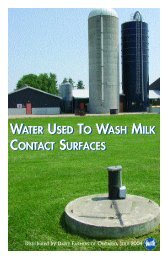Canadian Quality Milk On-Farm Food Safety Program - Centre ...
Canadian Quality Milk On-Farm Food Safety Program - Centre ...
Canadian Quality Milk On-Farm Food Safety Program - Centre ...
You also want an ePaper? Increase the reach of your titles
YUMPU automatically turns print PDFs into web optimized ePapers that Google loves.
<strong>Canadian</strong> <strong>Quality</strong> <strong>Milk</strong><br />
Check and record the temperature of the pre-rinse water (weekly) or wash<br />
water (monthly) (Record 13).<br />
Check and record the cleanliness of milking equipment regularly (e.g. receiver<br />
jar and bulk milk tank) (minimum acceptable frequency is monthly, weekly is<br />
recommended).<br />
Change the filter.<br />
• Describe how to shut the system down and change the filter.<br />
• Change the filter at the start of washing at least twice per day.<br />
• Check the filter for signs of mastitis and other debris. If you identify a problem,<br />
ensure that you follow corrective actions.<br />
Check the buffer tank and main bulk tank.<br />
• Post a milk pick-up/cleaning procedure for the milk truck drivers. The instructions<br />
should include how to switch diversion from the main tank to the buffer tank, how<br />
to start the wash for the main tank and how to start the cooler for the buffer tank.<br />
• Inspect the main bulk tank whenever it is empty to make sure it is clean (drying<br />
the bulk tank milk contact surfaces may help you detect deficiencies in surface<br />
cleaning).<br />
• Follow the same wash procedures for the buffer tank after milk transfer to the<br />
main tank, including sanitizing approximately prior to its use (if possible, check<br />
the main tank and the buffer tank when they are dry).<br />
• Sanitize the buffer tank about half an hour before the milk truck arrives.<br />
Teat Cleaning.<br />
• Observe teat cleaning and post spraying/dipping of one animal for each milking<br />
unit at least once a day.<br />
• Check that roller brushes are clean.<br />
Clean teats remain a concern with AMS. AMS are capable of cleaning, sanitizing<br />
and drying teats, but they may not do it well. Cattle in an AMS herd may be<br />
expected to be kept cleaner to reduce the incidence of dirty teats. The Hygiene<br />
Scoring Card in Chapter 1 of the Reference Manual shows you how to score the<br />
cleanliness of your cattle’s udders.<br />
Question 55: Do you have a functioning safety switch or fail-safe system in place<br />
to avoid accidental entry of wash water into the tank?<br />
An AMS does not have a safety switch but it must have a fail-safe system to keep<br />
antibiotic milk and wash water out of the tank. The device is also designed to err on the<br />
side of dumping clean milk if there is a malfunction.<br />
10—6<br />
June 2010
















